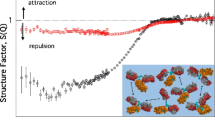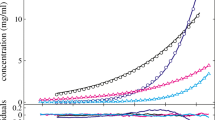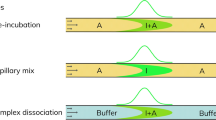Abstract
Both conformational and colloidal stability of therapeutic proteins must be closely monitored and thoroughly characterized to assess the long-term viability of drug products. We characterized the IgG1 NISTmAb reference material in its histidine formulation buffer and report our findings on the higher order structure and interactions of NISTmAb under a range of conditions. In this paper we present the analysis of experimental small-angle scattering data with atomistic molecular simulations to characterize the monodisperse dilute solution of NISTmAb. In part II we describe the characterization of the NISTmAb at high protein concentration (Castellanos et al. 2018). The NISTmAb was found to be a flexible protein with a radius of gyration of 49.0 ± 1.2 Å in histidine formulation buffer using a variety of neutron and X-ray scattering measurements. Scattering data were then modeled using molecular simulation. After building and validating a starting NISTmAb structure from the Fc and Fab crystallographic coordinates, molecular dynamics and torsion-angle Monte Carlo simulations were performed to explore the configuration space sampled in the NISTmAb and obtain ensembles of structures with atomistic detail that are consistent with the experimental data. Our results indicate that the small-angle scattering profiles of the NISTmAb can be modeled using ensembles of flexible structures that explore a wide configuration space. The NISTmAb is flexible in solution with no single preferred orientation of Fc and Fab domains, but with some regions of configuration space that are more consistent with measured scattering profiles. Analysis of inter-domain atomistic contacts indicated that all ensembles contained configurations where residues between domains are ≤ 4 Å, although few contacts were observed for variable and C H 3 regions.

Heavy atom self contact maps of the NISTmAb indicate a highly-flexible structure.











Similar content being viewed by others
Notes
Certain commercial equipment, instruments, materials, suppliers, or software are identified in this paper to foster understanding. Such identification does not imply recommendation or endorsement by the National Institute of Standards and Technology, nor does it imply that the materials or equipment identified are necessarily the best available for the purpose.
References
Abe Y, Gor J, Bracewell DG, Perkins SJ, Dalby PA. Masking of the fc region in human igg4 by constrained x-ray scattering modelling: implications for antibody function and therapy. Biochem J 2010;432(1): 101–114.
Arata Y, Honzawa M, Shimizu A. Proton nuclear magnetic resonance studies of human immunoglobulins: conformation of the hinge region of the igg1 immunoglobulin. Biochemistry 1980;19(22):5130–5135. PMID: 6257277.
Ashish SAK, Boone CD, Krueger JK. Global structure of hiv-1 neutralizing antibody igg1 b12 is asymmetric. Biochem Biophys Res Commun 2010;391(1):947–951.
Barnett GV, Qi W, Amin S, Lewis EN, Razinkov V, Kerwin B, Liu Y, Roberts CJ. Structural changes and aggregation mechanisms for anti-streptavidin igg1 at elevated concentration. J Phys Chem B 2015;119(49):15,150–15,163. PMID: 26563591.
Barnett GV, Razinkov V, Kerwin B, Laue T, Woodka AH, Butler PD, Perevozchikova T, Roberts CJ. Specific-ion effects on the aggregation mechanisms and protein–protein interactions for anti-streptavidin immunoglobulin gamma-1. J Phys Chem B 2015;119(18):5793–5804. PMID: 25885209.
Brookes EH, Anjum N, Curtis JE, Marru S, Singh R, Pierce M. Genapp module execution and airavata integration. 2014 9th gateway computing environments workshop; 2014. p. 9–12.
Castellanos MM, Mattison K, Krueger S, Curtis JE. Characterization of the NISTmAb Reference Material using small-angle scattering and molecular simulation. Part II: Concentrated protein solutions. Anal Bioanal Chem. (2018); https://doi.org/10.1007/s00216-018-0869-1.
Castellanos MM, McAuley A, Curtis JE. Investigating structure and dynamics of proteins in amorphous phases using neutron scattering. Comput Struct Biotechnol J 2016;15:117–130.
Castellanos MM, Pathak JA, Colby RH. Both protein adsorption and aggregation contribute to shear yielding and viscosity increase in protein solutions. Soft Matter 2014;10(1):122–131.
Castellanos MM, Pathak JA, Leach W, Bishop SM, Colby RH. Explaining the non-newtonian character of aggregating monoclonal antibody solutions using small-angle neutron scattering. Biophys J 2014;107(2): 469–476.
Chaves RC, Teulon JM, Odorico M, Parot P, Chen SWW, Pellequer JL. Conformational dynamics of individual antibodies using computational docking and afm. J Mol Recognit 2013;26 (11):596–604.
Clark NJ, Zhang H, Krueger S, Lee HJ, Ketchem RR, Kerwin B, Kanapuram SR, Treuheit MJ, McAuley A, Curtis JE. Small-angle neutron scattering study of a monoclonal antibody using free-energy constraints. J Phys Chem B 2013;117(45):14,029–14,038.
Curtis JE. SASSIE-web: https://sassie-web.chem.utk.edu/sassie2/.
Curtis JE, Raghunandan S, Nanda H, Krueger S. Sassie: a program to study intrinsically disordered biological molecules and macromolecular ensembles using experimental scattering restraints. Comput Phys Commun 2012;183(2):382–389.
Darden T, York D, Pedersen L. Particle mesh ewald: an n.log(n) method for ewald sums in large systems. J Chem Phys 1993;98 (12):10,089–10,092.
Debye P. Zerstreuung von röntgenstrahlen. Ann Phys 1915;351(6):809–823.
Dimitrov DS. Therapeutic proteins. Therapeutic proteins, methods in molecular biology, vol 899, book section 1. In: Voynov V and Caravella JA, editors. New York: Humana Press; 2010. p. 1–26.
Formolo T, Ly M, Levy M, Kilpatrick L, Lute S, Phinney K, Marzilli L, Brorson K, Boyne M, Davis D, Schiel J. Determination of the nistmab primary structure. State-of-the-Art and Emerging Technologies for Therapeutic Monoclonal Antibody Characterization Volume 2. Biopharmaceutical Characterization: the NISTmAb Case Study, chap. 1, pp. 1–62. ACS Symposium Series. In: Schiel JE, Davis DL, and Borisov OV, editors; 2015.
Godfrin PD, Zarraga IE, Zarzar J, Porcar L, Falus P, Wagner NJ, Liu Y. Effect of hierarchical cluster formation on the viscosity of concentrated monoclonal antibody formulations studied by neutron scattering. J Phys Chem B 2016;120(2):278–291.
Gokarn Y, Agarwal S, Arthur K, Bepperling A, Day ES, Filoti D, Greene DG, Hayes D, Kroe-Barrett R, Laue T, Lin J, McGarry B, Razinkov V, Singh S, Taing R, Venkataramani S, Weiss W, Yang D, Zarraga IE. 2015. Biophysical Techniques for Characterizing the Higher Order Structure and Interactions of Monoclonal Antibodies, chap. 6, pp. 285–327 ACS Symposium Series.
Grillo I. Small-angle neutron scattering and applications in soft condensed matter. Soft matter characterization, chap. 13. In: Borsali R and Pecora R, editors. Dordrecht: Springer; 2008. p. 723–782.
Guinier A. Théorie et technique de la radiocristallographie. Paris: Dunod; 1956.
Hammouda B. 2016. Probing nanoscale structures-the sans toolbox. Natl. Institute Standards Technology Center for Neutron Research, Gaithersburg, MD p. https://www.ncnr.nist.gov/staff/hammouda/theSANStoolbox.pdf.
Hanson DC, Yguerabide J, Schumaker VN. Segmental flexibility of immunoglobulin g antibody molecules in solution: a new interpretation. Biochemistry 1981;20(24):6842–6852. PMID: 7317358.
Humphrey W, Dalke A, Schulten K. Vmd: visual molecular dynamics. J Mol Graphics Modell 1996;14 (1):33–38.
Inouye H, Houde D, Temel DB, Makowski L. Utility of solution x-ray scattering for the development of antibody biopharmaceuticals. J Pharm Sci 2016;105(11):3278–3289.
Jacrot B. The study of biological structures by neutron scattering from solution. Rep Prog Phys 1976;39(10): 911.
Jordan A, Jacques M, Merrick C, Devos J, Forsyth VT, Porcar L, Martel A. SEC-SANS: Size exclusion chromatography combined in situ with small-angle neutron scattering. J Appl Crystallogr 2016;49(6): 2015–2020.
Jorgensen WL, Chandrasekhar J, Madura JD, Impey RW, Klein ML. Comparison of simple potential functions for simulating liquid water. J Chem Phys 1983;79(2):926–935.
Kline S. Reduction and analysis of sans and usans data using igor pro. J Appl Crystallogr 2006;39(6):895–900.
Lilyestrom WG, Shire SJ, Scherer TM. Influence of the cosolute environment on igg solution structure analyzed by small-angle x-ray scattering. J Phys Chem B 2012;116(32):9611–9618.
Mathew E, Mirza A, Menhart N. Liquid-chromatography-coupled SAXS for accurate sizing of aggregating proteins. J Synchrotron Rad 2004;11(4):314–318.
McCammon JA, Karplus M. Internal motions of antibody molecules. Nature 1977;268(5622):765–766.
Mosbæk CR, Konarev PV, Svergun DI, Rischel C, Vestergaard B. High concentration formulation studies of an igg2 antibody using small angle x-ray scattering. Pharm Res 2012;29(8):2225–2235.
Nielsen SS, Toft KN, Snakenborg D, Jeppesen MG, Jacobsen JK, Vestergaard B, Kutter JP, Arleth L. BioXTAS RAW, a software program for high-throughput automated small-angle X-ray scattering data reduction and preliminary analysis. J Appl Crystallogr 2009;42(5):959–964.
Orthaber D, Bergmann A, Glatter O. SAXS Experiments on absolute scale with Kratky systems using water as a secondary standard. J Appl Crystallogr 2000;33(2):218–225.
Perkins SJ, Bonner A. Structure determinations of human and chimaeric antibodies by solution scattering and constrained molecular modelling. Biochem Soc Trans 2008;36(1):37–42.
Perkins SJ, Okemefuna AI, Nan R, Li K, Bonner A. Constrained solution scattering modelling of human antibodies and complement proteins reveals novel biological insights. J Royal Soc Inter 2009;6(Suppl 5): S679–S696.
Perkins SJ, Wright DW, Zhang H, Brookes EH, Chen J, Irving TC, Krueger S, Barlow DJ, Edler KJ, Scott DJ, Terrill NJ, King SM, Butler PD, Curtis JE. Atomistic modelling of scattering data in the Collaborative Computational Project for Small Angle Scattering (CCP-SAS). J Appl Crystallogr 2016;49 (6):1861–1875.
Pernot P, Round A, Barrett R, De Maria Antolinos A, Gobbo A, Gordon E, Huet J, Kieffer J, Lentini M, Mattenet M, Morawe C, Mueller-Dieckmann C, Ohlsson S, Schmid W, Surr J, Theveneau P, Zerrad L, McSweeney S. Upgraded ESRF BM29 beamline for SAXS on macromolecules in solution. J Synchrotron Rad 2013;20(4):660–664.
Phillips JC, Braun R, Wang W, Gumbart J, Tajkhorshid E, Villa E, Chipot C, Skeel RD, Kalé L, Schulten K. Scalable molecular dynamics with namd. J Comput Chem 2005;26(16):1781–1802.
Prien JM, Stöckmann H, Albrecht S, Martin SM, Varatta M, Furtado M, Hosselet S, Wang M, Formolo T, Rudd PM, Schiel JE. Orthogonal technologies for nistmab n-glycan structure elucidation and quantitation. State-of-the-Art and Emerging Technologies for Therapeutic Monoclonal Antibody Characterization Volume 2. Biopharmaceutical Characterization: The NISTmAb Case Study, chap. 4, pp. 185–235. ACS Symposium Series. In: Schiel JE, Davis DL, and Borisov OV, editors; 2015.
Putnam CD, Hammel M, Hura GL, Tainer JA. X-ray solution scattering (saxs) combined with crystallography and computation: defining accurate macromolecular structures, conformations and assemblies in solution. Q Rev Biophys 2007;40(3):191– 285.
Rambo RP. ScÅtter: http://www.bioisis.net/tutorial/9.
Rayner LE, Hui GK, Gor J, Heenan RK, Dalby PA, Perkins SJ. The solution structures of two human igg1 antibodies show conformational stability and accommodate their c1q and fcγ r ligands. J Biol Chem 2015;290(13):8420–8438.
Reichert JM. Marketed therapeutic antibodies compendium. MAbs 2012;4(3):413–415.
Reichert JM. Antibodies to watch in 2017. MAbs 2017;9(2):167–181. PMID: 27960628.
Ryckaert JP, Ciccotti G, Berendsen HJC. Numerical integration of the cartesian equations of motion of a system with constraints: molecular dynamics of n-alkanes. J Comput Phys 1977;23(3):327–341.
Saphire EO, Parren PWHI, Barbas Carlos FI, Burton DR, Wilson IA. Crystallization and preliminary structure determination of an intact human immunoglobulin, b12: an antibody that broadly neutralizes primary isolates of hiv-1. Acta Crystallogr, Sect D 2001;57(1):168–171.
Schiel JE, Davis D, Borisov OV. State-of-the-art and emerging technologies for therapeutic monoclonal antibody characterization volume 1. monoclonal antibody therapeutics: structure, function, and regulatory space. State-of-the-Art and Emerging Technologies for Therapeutic Monoclonal Antibody Characterization Volume 1. Monoclonal Antibody Therapeutics: Structure, Function, and Regulatory Space, vol. 1, pp. ix–xi. ACS Symposium Series. In: Schiel JE, Davis DL, and Borisov OV, editors; 2014.
Schiel JE, Davis D, Borisov OV. State-of-the-art and emerging technologies for therapeutic monoclonal antibody characterization volume 2. biopharmaceutical characterization: The nistmab case study. State-of-the-art and emerging technologies for therapeutic monoclonal antibody characterization volume 2. Biopharmaceutical Characterization: The NISTmAb Case Study, pp. ix–xii. ACS Symposium Series. In: Schiel JE, Davis DL, and Borisov OV, editors; 2015.
Schiel JE, Davis D, Borisov OV. State-of-the-art and emerging technologies for therapeutic monoclonal antibody characterization volume 3. defining the next generation of analytical and biophysical techniques. State-of-the-Art and Emerging Technologies for Therapeutic Monoclonal Antibody Characterization Volume 3. Defining the Next Generation of Analytical and Biophysical Techniques, pp. ix–x. ACS Symposium Series. In: Schiel JE, Davis DL, and Borisov OV, editors; 2015.
Schiel JE, Mire-Sluis A, Davis D. Monoclonal antibody therapeutics: The need for biopharmaceutical reference materials. State-of-the-Art and Emerging Technologies for Therapeutic Monoclonal Antibody Characterization Volume 1. Monoclonal Antibody Therapeutics: Structure, Function, and Regulatory Space, vol. 1, chap. 1, pp. 1–34. ACS Symposium Series. In: Schiel JE, Davis DL, and Borisov OV, editors; 2014.
Stuhrmann HB. Small-angle scattering and its interplay with crystallography, contrast variation in SAXS and SANS. Acta Crystallographica Sect A 2008;64(1):181–191.
Svergun DI, Koch MHJ. Small-angle scattering studies of biological macromolecules in solution. Rep Prog Phys 2003;66(10):1735–1782.
Tian X, Langkilde AE, Thorolfsson M, Rasmussen HB, Vestergaard B. Small-angle x-ray scattering screening complements conventional biophysical analysis: Comparative structural and biophysical analysis of monoclonal antibodies igg1, igg2, and igg4. J Pharm Sci 2014;103(6):1701–1710.
Tian X, Vestergaard B, Thorolfsson M, Yang Z, Rasmussen HB, Langkilde AE. In-depth analysis of subclass-specific conformational preferences of igg antibodies. IUCrJ 2015;2(Pt 1):9–18.
Vanommeslaeghe K, Hatcher E, Acharya C, Kundu S, Zhong S, Shim J, Darian E, Guvench O, Lopes P, Vorobyov I, Mackerell AD. Charmm general force field: a force field for drug-like molecules compatible with the charmm all-atom additive biological force fields. J Comput Chem 2009;31(4):671–690.
Watson MC, Curtis JE. Rapid and accurate calculation of small-angle scattering profiles using the golden ratio. J Appl Crystallogr 2013;46(4):1171–1177.
Wilhelm P, Friguet B, Djavadi-Ohaniance L, Pilz I, Goldberg ME. Epitope localization in antigen-monoclonal-antibody complexes by small-angle x-ray scattering. Eur J Biochem 1987;164 (1):103–109.
Yearley EJ, Zarraga IE, Shire SJ, Scherer TM, Gokarn Y, Wagner NJ, Liu Y. Small-angle neutron scattering characterization of monoclonal antibody conformations and interactions at high concentrations. Biophys J 2013;105(3):720–731.
Yguerabide J, Epstein HF, Stryer L. Segmental flexibility in an antibody molecule. J Mol Biol 1970;51 (3):573–590.
Zaccai NR, Sandlin CW, Hoopes JT, Curtis JE, Fleming PJ, Fleming KG, Krueger S. Chapter six - deuterium labeling together with contrast variation small-angle neutron scattering suggests how skp captures and releases unfolded outer membrane proteins. Isotope labeling of biomolecules - applications, methods in enzymology. In: Kelman Z, editors. Academic Press; 2016. p. 159–210.
Zhang X, Zhang L, Tong H, Peng B, Rames MJ, Zhang S, Ren G. 2015. 3d structural fluctuation of igg1 antibody revealed by individual particle electron tomography. Sci. Rep. 5 9803 EP.
Acknowledgements
The authors acknowledge the following scientists for supporting this work: Emilie Poudevigne (previously affiliated with ESRF) for collecting SAXS data at the ESRF, Zhiyuan Wang (Tsinghua University) and Yun Liu (NIST, University of Delaware) for their help with SANS data collection, John Schiel (NIST, IBBR) for making the material available for this study and for helping with the SEC measurements, James Snyder (NIST) for performing the energy minimization of the resulting structures from the torsion-angle MC simulation. MMC acknowledges financial support from the NIST biomanufacturing initiative. SCH acknowledges financial support from the NIST NRC Postdoctoral Research Associateship Program. This work used CCP-SAS software developed through a joint EPSRC (EP/K039121/1) and NSF (CHE-1265821) grant.
Author information
Authors and Affiliations
Corresponding author
Ethics declarations
Conflict of interests
All authors of this article declare no conflict of interest.
Electronic supplementary material
Below is the link to the electronic supplementary material.
Rights and permissions
About this article
Cite this article
Castellanos, M.M., Howell, S.C., Gallagher, D.T. et al. Characterization of the NISTmAb Reference Material using small-angle scattering and molecular simulation. Anal Bioanal Chem 410, 2141–2159 (2018). https://doi.org/10.1007/s00216-018-0868-2
Received:
Revised:
Accepted:
Published:
Issue Date:
DOI: https://doi.org/10.1007/s00216-018-0868-2




